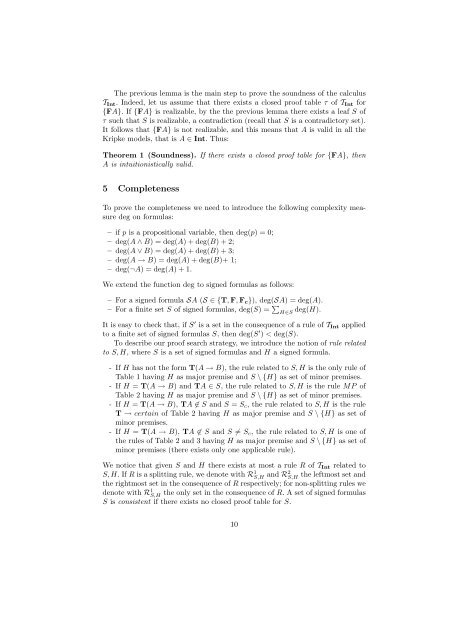A refined calculus for Intuitionistic Propositional Logic - DISCo
A refined calculus for Intuitionistic Propositional Logic - DISCo
A refined calculus for Intuitionistic Propositional Logic - DISCo
Create successful ePaper yourself
Turn your PDF publications into a flip-book with our unique Google optimized e-Paper software.
The previous lemma is the main step to prove the soundness of the <strong>calculus</strong>T Int . Indeed, let us assume that there exists a closed proof table τ of T Int <strong>for</strong>{FA}. If {FA} is realizable, by the the previous lemma there exists a leaf S ofτ such that S is realizable, a contradiction (recall that S is a contradictory set).It follows that {FA} is not realizable, and this means that A is valid in all theKripke models, that is A ∈ Int. Thus:Theorem 1 (Soundness). If there exists a closed proof table <strong>for</strong> {FA}, thenA is intuitionistically valid.5 CompletenessTo prove the completeness we need to introduce the following complexity measuredeg on <strong>for</strong>mulas:– if p is a propositional variable, then deg(p) = 0;– deg(A ∧ B) = deg(A) + deg(B) + 2;– deg(A ∨ B) = deg(A) + deg(B) + 3;– deg(A → B) = deg(A) + deg(B)+ 1;– deg(¬A) = deg(A) + 1.We extend the function deg to signed <strong>for</strong>mulas as follows:– For a signed <strong>for</strong>mula SA (S ∈ {T, F, F c }), deg(SA) = deg(A).– For a finite set S of signed <strong>for</strong>mulas, deg(S) = ∑ H∈S deg(H).It is easy to check that, if S ′ is a set in the consequence of a rule of T Int appliedto a finite set of signed <strong>for</strong>mulas S, then deg(S ′ ) < deg(S).To describe our proof search strategy, we introduce the notion of rule relatedto S, H, where S is a set of signed <strong>for</strong>mulas and H a signed <strong>for</strong>mula.- If H has not the <strong>for</strong>m T(A → B), the rule related to S, H is the only rule ofTable 1 having H as major premise and S \ {H} as set of minor premises.- If H = T(A → B) and TA ∈ S, the rule related to S, H is the rule MP ofTable 2 having H as major premise and S \ {H} as set of minor premises.- If H = T(A → B), TA ∉ S and S = S c , the rule related to S, H is the ruleT → certain of Table 2 having H as major premise and S \ {H} as set ofminor premises.- If H = T(A → B), TA ∉ S and S ≠ S c , the rule related to S, H is one ofthe rules of Table 2 and 3 having H as major premise and S \ {H} as set ofminor premises (there exists only one applicable rule).We notice that given S and H there exists at most a rule R of T Int related toS, H. If R is a splitting rule, we denote with R 1 S,H and R2 S,H the leftmost set andthe rightmost set in the consequence of R respectively; <strong>for</strong> non-splitting rules wedenote with R 1 S,H the only set in the consequence of R. A set of signed <strong>for</strong>mulasS is consistent if there exists no closed proof table <strong>for</strong> S.10
















